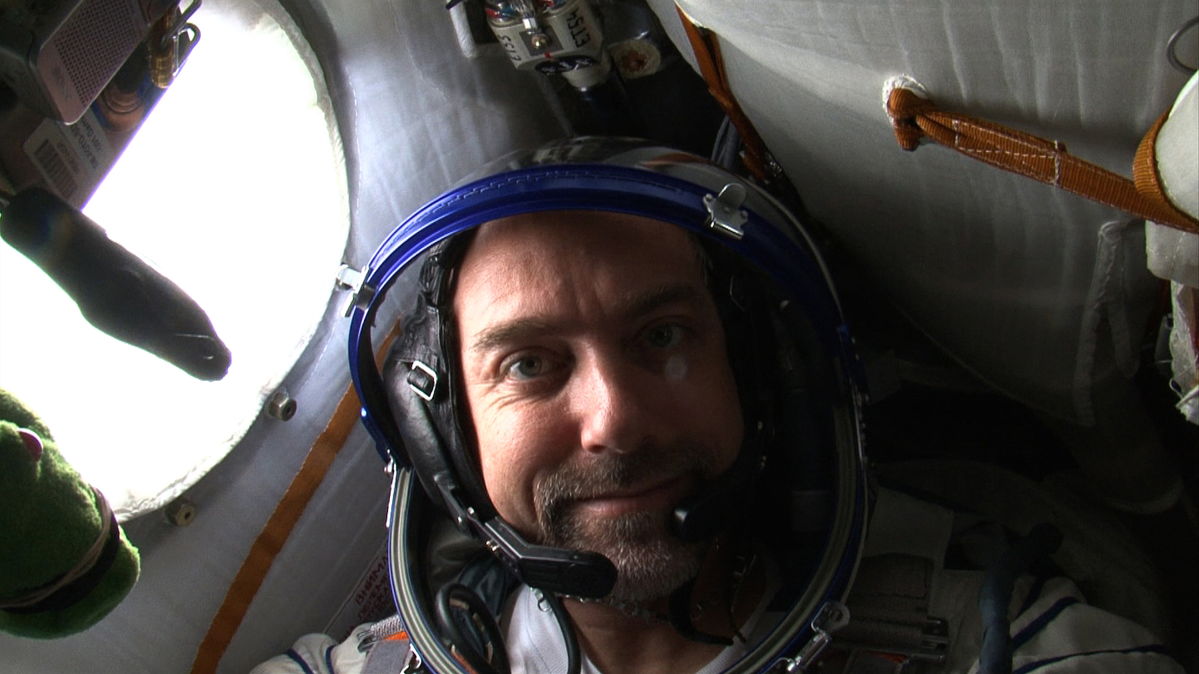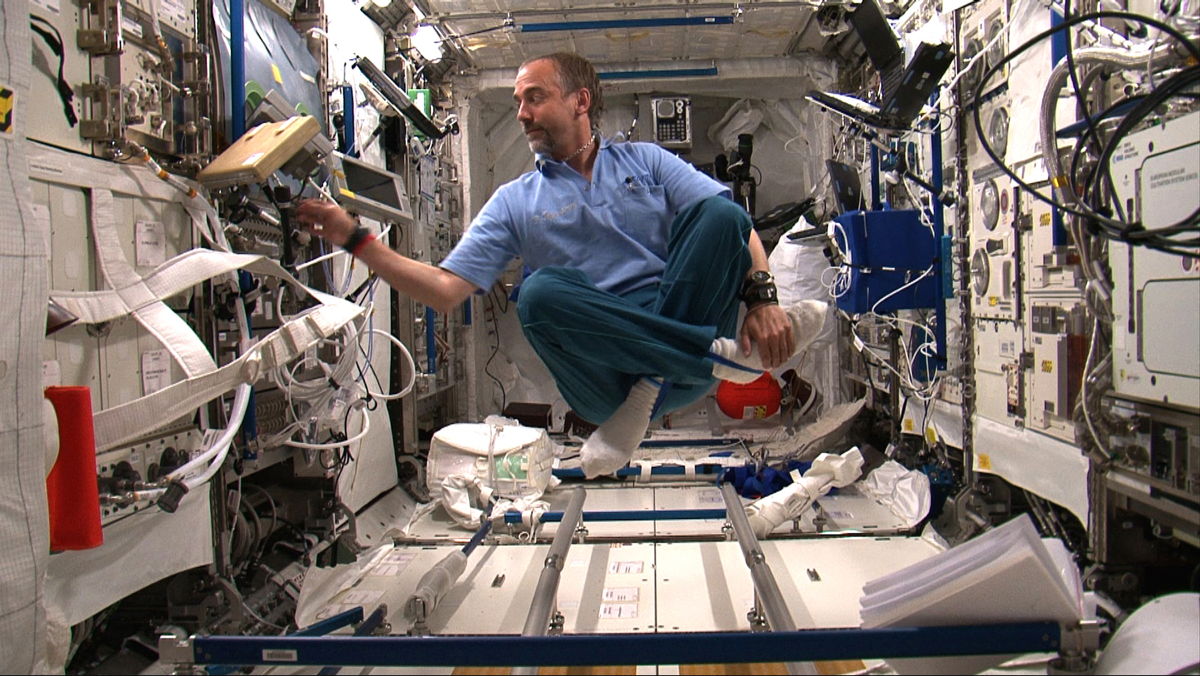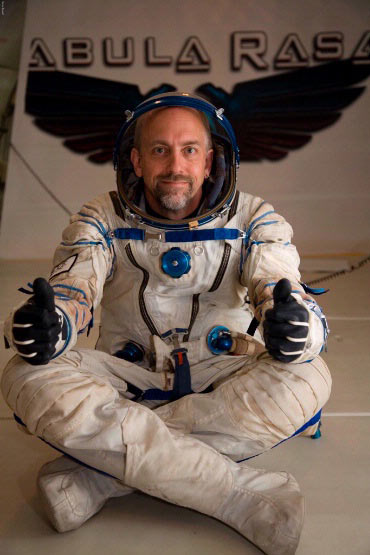'Man on a Mission' Film Shows Space Traveler Following Dad into Orbit

NEW YORK - Richard Garriott is not your ordinary nerd.
Yes, he is a self-proclaimed space fan and develops computer games for a living. But he's also the millionaire founder of the "Ultima Online" computer game franchise, uses a robot to telecommute between New York and his Austin office, and is one of the few people ever to pay $30 million for a cosmic trip to the International Space Station.
And there's one more thing: Richard Garriott is the son of Owen Garriott, a former NASA astronaut who flew on the U.S. Skylab station and space shuttle. He is the first American second-generation spaceflyer ever to follow a parent off the planet.
It's that combination of spaceflight and computer games that comes through in "Man on a Mission," a new documentary launching into theaters today (Jan. 13) across the United States. The film, directed by veteran documentary director Mike Woolf, chronicles Garriott's 2008 flight to the International Space Station. [Photos: Richard Garriott's Private Spaceflight]
Mission: Space
Garriott, 50, grew up in Houston, the home of NASA's Mission Control at the Johnson Space Center, in a neighborhood filled with astronauts and their families. He watched his father launch to the Skylab space station in 1973, and then on a space shuttle in 1983.
"I kind of grew up in a community where going into space seemed fairly normal, and not unusual or necessarily difficult," Garriott told SPACE.com. "I just assumed that everyone went to space when they grew up because everyone I knew did go to space when they grew up."
Get the Space.com Newsletter
Breaking space news, the latest updates on rocket launches, skywatching events and more!
But Garriott wore glasses, and when he was 13 years old, a NASA doctor told him that flying in space with less than perfect eyesight was not in the cards. Instead, he took up computer games and the moniker "Lord British," built a computer gaming empire that earned millions and devoted the next few decades to investing in new companies and technology aimed at allowing private citizens like him to reach space.
It happened in 2008.

Garriott flew to the space station under a deal with Russia's Federal Space Agency brokered by the Virginia-based space tourism company Space Adventures, a firm that has arranged eight such flights for seven customers (one passenger flew twice) since 2001. Garriott paid $30 million to launch into orbit aboard a Russian Soyuz space capsule with two professional astronauts — one Russian, the other American — who were starting a months-long mission to the space station.
The view from space is probably the most often touted by professional astronauts, and Garriott agreed. The experience, he said, was life-changing, especially when he spotted locations (like his current home city of Austin) and was able to finally see the scale of the Earth and humanity's impact on its surface.
"It hit me that I now know the true scale of the Earth by direct observation," Garriott said. "Suddenly the Earth just felt both finite and small." [Earth from Space: Amazing Astronaut Photos]
Private spaceflight is a growing industry, and with NASA's space shuttle fleet now retired the U.S. space agency is turning to commercial companies to build new spaceships to fly American astronauts to the space station and back.

Garriott said that mode of operation is a stepping stone for the future of human spaceflight, one that could bring the cost of spaceflight per person down from the tens of millions to just a few million dollars — still out of reach for most of the public, but potentially within the grasp of companies hoping to exploit the business side of space.
Private spaceman
Garriott's trip lasted 12 days, enough time to visit the station, perform a packed schedule of experiments, enjoy the view of Earth and then return home with the station's outgoing crew. By coincidence, one of the returning station crew was cosmonaut Sergei Volkov — whose father was also a noted Russian cosmonaut.
It's the training for that flight that Woolf uses to kick off "Man on a Mission," which then follows Garriott through the spacesuit fittings, emergency drills, spaceflight traditions and – what Garriott said was the hardest thing about the trip – learning the Russian language.

What's striking about "Man on a Mission" is that it could have very easily been just a glorified home movie, a sort of millionaire vanity film, of the rich and famous in space. But instead, the film offers a revealing look behind the scenes of Russia's space program.
Russia was the first country ever to launch a satellite into space (Sputnik in 1957) and a human into orbit (Yuri Gagarin in 1961), missions that launched more than 50 years of spaceflight. In "Man on a Mission," Garriott serves as a tour guide for that long pace legacy, which has been tarnished in the last year due to a series of unmanned rocket failures and the impending crash of the robotic Mars probe Phobos-Grunt, which is due to fall to Earth in the next few days.
Even in 2008, there were some concerns over the safety of Russia's Soyuz spacecraft after two returning capsules landed in back-up ballistic modes. The capsule Garriott returned home was repaired in space in unprecedented spacewalk in which cosmonauts removed a faulty explosive bolt from the spacecraft.
In the film, Garriott holds up a small metal cylinder, a bomb-proof container, holding the bolt. The Soyuz fix worked and Garriott and his crewmates landed in Kazakhstan just fine. Garriott's video camera catches a spectacular view of re-entry through his window, an event rarely seen publicly from Russian spacecraft.
Despite its troubles, Russia's space program has always been somewhat underappreciated by the American public, which tends to focus solely on U.S. achievements, Garriott said. He added that he's confident Russian space officials will overcome their current challenges and continue their cosmic legacy.
Garriott said there is one thing you won't see in "Man on a Mission": his science fiction film that he shot while living on the International Space Station. Called "Apogee of Fear," the short film included the station's NASA astronaut crew and follows them as they investigate mysterious happenings in orbit.
"It does exist. I actually think it's a great film. It's a bit tongue in cheek and of course the acting quality varies a bit throughout the film," Garriott said. "NASA has, so far, decided that since its filmed onboard NASA hardware and uses NASA astronauts as actors, that they have resisted me releasing it publicly."
Today, Garriott is in the midst of his latest mission, perhaps the hardest mission yet: married life. Last year, he wed longtime friend Laetitia Pichot de Cayeux.
"Man on a Mission" opens Friday (Jan. 13) at select theaters across the United States.
You can follow Tariq Malik on Twitter @tariqjmalik. Follow SPACE.com for the latest in space science and exploration news on Twitter @Spacedotcom and on Facebook.
Join our Space Forums to keep talking space on the latest missions, night sky and more! And if you have a news tip, correction or comment, let us know at: community@space.com.

Tariq is the Editor-in-Chief of Space.com and joined the team in 2001, first as an intern and staff writer, and later as an editor. He covers human spaceflight, exploration and space science, as well as skywatching and entertainment. He became Space.com's Managing Editor in 2009 and Editor-in-Chief in 2019. Before joining Space.com, Tariq was a staff reporter for The Los Angeles Times covering education and city beats in La Habra, Fullerton and Huntington Beach. In October 2022, Tariq received the Harry Kolcum Award for excellence in space reporting from the National Space Club Florida Committee. He is also an Eagle Scout (yes, he has the Space Exploration merit badge) and went to Space Camp four times as a kid and a fifth time as an adult. He has journalism degrees from the University of Southern California and New York University. You can find Tariq at Space.com and as the co-host to the This Week In Space podcast with space historian Rod Pyle on the TWiT network. To see his latest project, you can follow Tariq on Twitter @tariqjmalik.
